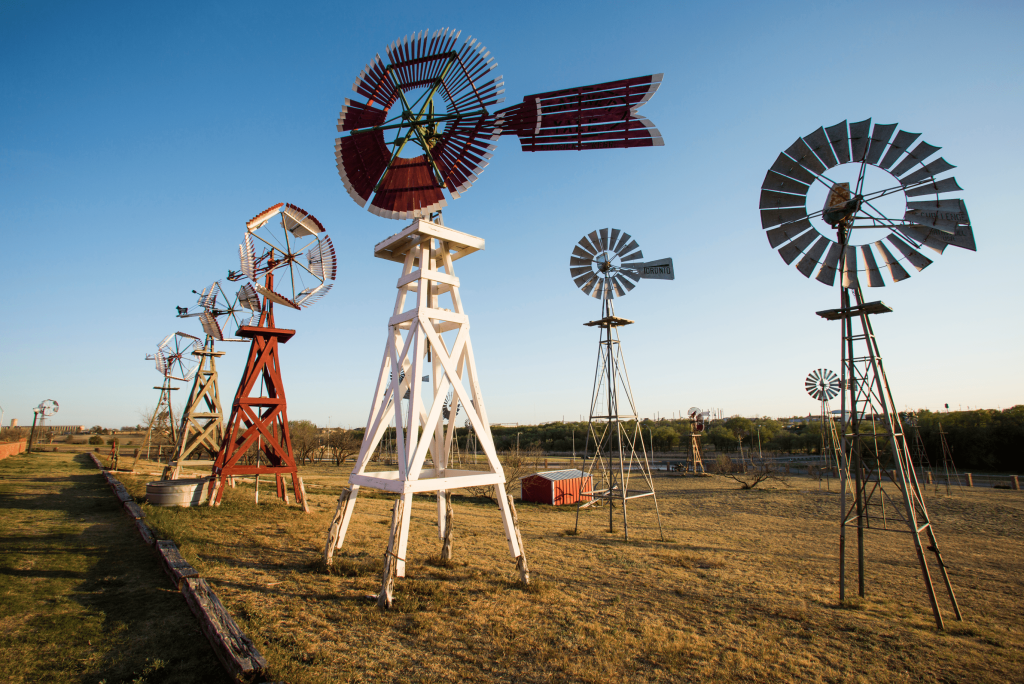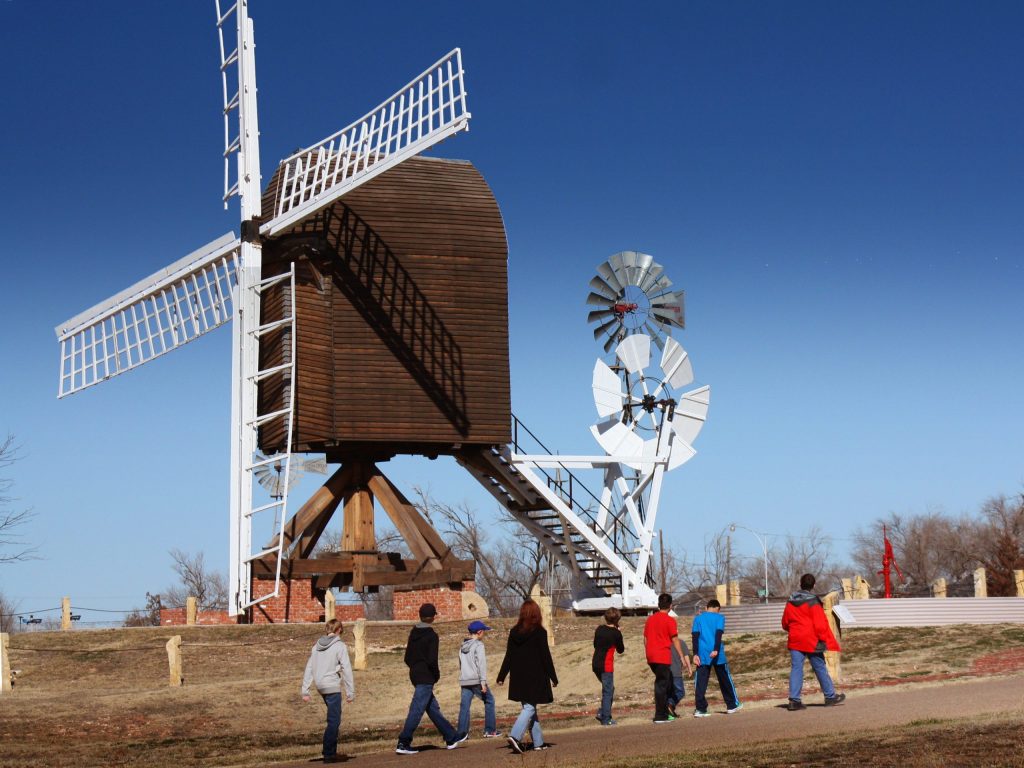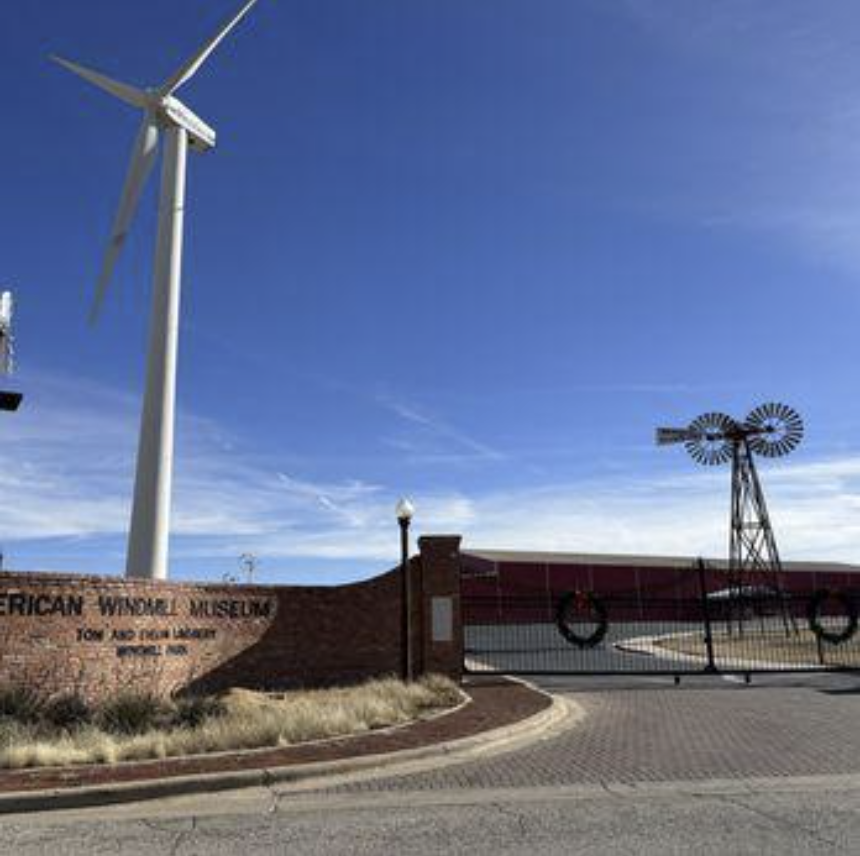The Grounds

Linebery Windmill Park
On the 28 acre park grounds sit over 70 historic windmills. Some of these mills actually pump water from a well and others are set up to recirculate water from a tank, while others are simply showing their historic beauty.

Flowerdew Hundred Post Mill
Hundred Postmill is now assembled on the grounds of the American Windmill Museum.
The first windmill to be built in North America was constructed in 1621 for Sir George Yeardley on his plantation, Flowerdew Hundred, in Virginia. The original windmill was destroyed in a storm, but remains were found in later excavations.
In 1978 a new, commemorative windmill was built at Flowerdew Hundred incorporating features that illustrate the development of English windmill technology through the 18th century. In the summer of 2010 this commemorative mill was moved from Virginia to its current home in Lubbock, Texas and is one of the very few working Post-Mills in the Western Hemisphere.

VESTAS Model V47
The Vestas V47 is a wind machine capable of generating vast quantities of electricity. Since the wind is a low-density energy source, a large capture device (a big wheel) is needed to make electric power economically. The electricity produced by the V47 is used to power the American Windmill Museum. Even more electricity than is required is generated and this excess energy is fed into the local utility’s power lines. No battery storage is needed, since 60 cycle, 3 phase AC power is produced.
The Windmill Museum’s VESTAS turbine generates about one million kilowatt hours of electricity each year. The museum uses about half of the power generated and the excess energy is sold back into the grid.
The Foundation – is 26 feet deep. 80 anchor bolts, each 26 feet long, tie the tower’s base to the foundation. 160 yards of concrete were used. The Center section of the foundation is filled with soil.
The Steel Tower – is 50 meters tall or 164 feet from the base to the midpoint of the rotor. It is a monopole design and weighs over 97,000 pounds.
The Blades/ Rotor – is 155 feet (47 meters) in diameter. Each fiberglass blade is 23.5 meters or 77 feet long. The blades and hub when assembled weigh 15,876 pounds. The rotor turns at 28.5 rpm and is an upwind design. During startup and high wind operation the blades are varied in pitch.
The Nacelle – houses the generator, a 1:63 ratio gearbox, brakes, orienting motors and weighs 44,982 pounds. The 660-kilowatt asynchronous generator produces 690 volts of ac current at 614 amps. The generator starts producing power in a 10-11 mph wind. The rotor is stopped when winds exceed 55 mph.
The GE 1.5s Wind Turbine is rated at 1.5 megawatts in a 28-mph wind and is the machine used in most wind farms today.
The Blades – are 112 feet long and each one weighs 12,000 pounds. They are made of primarily of fiberglass with steel roots. A lightning protection cable runs the full length of the blade.
The Hub – is a single casting and weighs about 37,000 pounds. Three DC pitch drive motors and their controls are housed inside this large casting. When the rotor blades are bolted to the large openings in the hub, the wheel measures 231 feet in diameter.
The Nacelle – is 29 feet long and 12 feet in height. A 1.5-megawatt generator mounted inside is coupled to a multi-stage planetary gearbox. The braking system, cooling fans, orienting motors, and controls are inside this fiberglass box and when filled it weighs over 110,000 pounds.
Wind turbines of this size are usually erected on towers that are 60 to 80 meters or 200 to 260 feet in height. The taller towers have elevators. These wind turbines can generate enough electrical power to supply the needs of 500-700 homes. Each one costs over $2 million installed.
General Electric Wind Systems donated the GE 1.5s turbine to the Windmill Museum. It was originally erected in Tehachapi, California and was used as a test machine for turbine development.
Transportation and display of the GE Turbine was made possible by grants from the Helen Jones foundation, Lubbock, Texas.
Behind the GE nacelle are components from a larger wind turbine, a 2.4-megawatt turbine made by Mitsubishi in Japan. The hub would carry three blades that are each 150 feet long. When the turbine is assembled, the wheel rotates at 9 to 16 rpm and drives an 82.7 ratio gearbox connected to the generator.
The Houston Endowment, Houston, Texas and the CH Foundation, Lubbock provided most of the funding for acquisition of the $1,000,000 VESTAS wind turbine.
